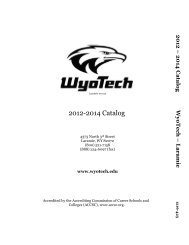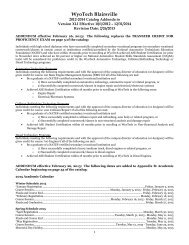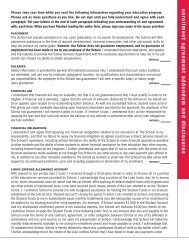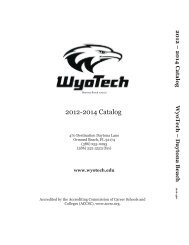2009-2010 Catalog 2009-2010 Catalog - WyoTech Tour
2009-2010 Catalog 2009-2010 Catalog - WyoTech Tour
2009-2010 Catalog 2009-2010 Catalog - WyoTech Tour
You also want an ePaper? Increase the reach of your titles
YUMPU automatically turns print PDFs into web optimized ePapers that Google loves.
• The student must develop an academic advising plan with his/her advisor;• The student must bring his/her CGAP up to the probation range by the end of the evaluation period following theappeal.If the student meets the above conditions, s/he may remain in school and is considered to be making SAP so long as thestudent’s CGAP does not fall below the probation range.DismissalStudents who have been readmitted following academic suspension who fail to improve their CGAP and/or ROP into theapplicable probation range by the end of the first evaluation period after readmission must be dismissed from the program.Students who have been dismissed from a program are not eligible for readmission.GraduationStudents must complete their program within the maximum time frame and with a 70% CGAP as stated in the schoolcatalog in order to graduate.Application of Grades and Credits• Grades of 100% through 0% (A through F) are included in the calculation of CGAP and are included in the TotalNumber of Clock Hours Attempted.• Transfer credits (T) are not included in the calculation of CGAP, but are included in the Total Number of Clock HoursAttempted (see below) in order to determine the required levels for CGAP and rate of progress. Transfer credits areincluded as clock hours attempted and successfully completed in calculating the rate of progress.• Developmental courses, non-credit, and remedial courses (PF, PP, CR, NC) are graded on a pass/fail basis and are notincluded in the calculation of progress toward completion or the student’s CGAP.• For calculating rate of progress, grades below 70% and W (Withdrawn) grades are counted as hours attempted, but arenot counted as successfully completed. Grades of I (Incomplete) will also be counted as hours attempted, but not ashours successfully completed; however, when the I is replaced with a grade, the CGAP and satisfactory academicprogress determination will be recalculated based on that grade and the clock hours earned.• When a course is repeated, the higher of the two grades is used in the calculation of CGAP and the total clock hours forthe original course and the repeated course are included in the Total Clock Hours Attempted (in the previousSatisfactory Academic Progress Charts) in order to determine the required progress level. The clock hours for theoriginal attempt are considered as not successfully completed.Transfer CreditStudents may receive transfer credit for courses taken at another school. Courses for which a student receives transfercredit are counted as attempted and successfully completed for purposes of satisfactory academic progress. As a result, coursesfor which a student receives transfer credit provide the student with advanced standing, which is applied to the student’sprogress in calculation of the percentage of maximum time frame for the program that the student has completed. For instance,if a student enrolled in a 1,500 clock hours program (with a maximum time frame of 2,250 clock hours) receives 250 clock hoursof transfer credit and completes 250 clock hours in the first term of enrollment, the student will be evaluated as a student whohas passed the 25% point of the program (500/1500 = 33.3%) at the end of the first term. However, if a student receives 500clock hours of transfer credit and will complete 250 clock hours at the end of the first term, the student will be evaluated as astudent who is at the midpoint (50% point) of the program (750/1500 = 50%).When a student transfers from or completes one program at the school and enrolls in another program, and all coursescompleted in the original program are acceptable for credit in the new program, all courses attempted and grades received in theoriginal program are counted in the new program for calculation of the student’s satisfactory academic progress in the newprogram. When a student transfers from or completes one program at the school and enrolls in another program at the schooland all courses completed in the original program are NOT accepted for credit in the new program, all attempts for coursestaken in the original program that are part of the new program will be counted in the calculation of the student’s satisfactoryacademic progress upon entry into the new program and the grades for the courses that are a part of the new program that weretaken at the same institution will be used in the student’s CGAP calculation.Satisfactory Academic Progress and Financial AidStudents must meet the standards of satisfactory academic progress in order to remain eligible to continue receivingfinancial assistance as well as to remain eligible to continue as a student of the school.The Financial Aid Office will provide details to all eligible recipients. Students should read these standards carefully andrefer any questions to Academic or Financial Aid Office personnel. Satisfactory academic progress for purposes of determiningcontinuing federal financial assistance is determined by applying the CGAP requirements, rate of progress requirements,maximum completion time restrictions, probation provisions, suspensions and dismissal procedures, and appeals procedures asoutlined in the satisfactory academic progress section of the catalog.Students on academic probation are considered to be maintaining satisfactory academic progress and are eligible tocontinue receiving federal financial assistance. Students who have been academically suspended or dismissed are no longeractive students of the School and are ineligible for financial aid. Reinstatement of financial aid eligibility will occur only afterreadmission following suspension or in the event the student’s appeal results in readmission.12














